
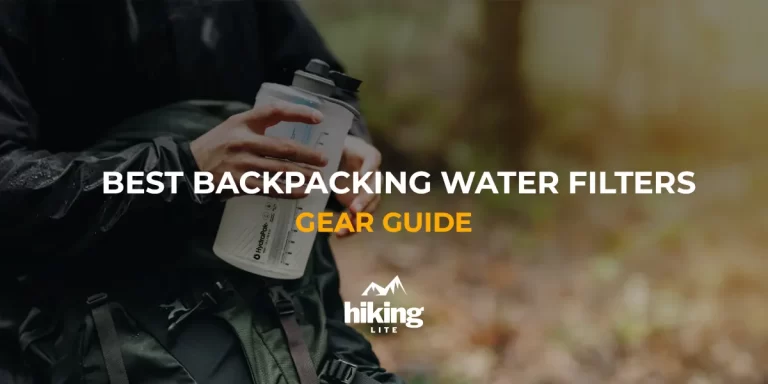
Looking for the best backpacking water filter for your next trip? No need to worry, you are in the right place.
Before choosing, you need to consider key factors for backpacking filters, like weight, effectiveness, ease of use, durability, and treatment speed.
Be sure to understand the difference between a water filter and purifier before deciding. More info about the distinction is at the end.
Now, let’s begin with the best and lightest choices available.
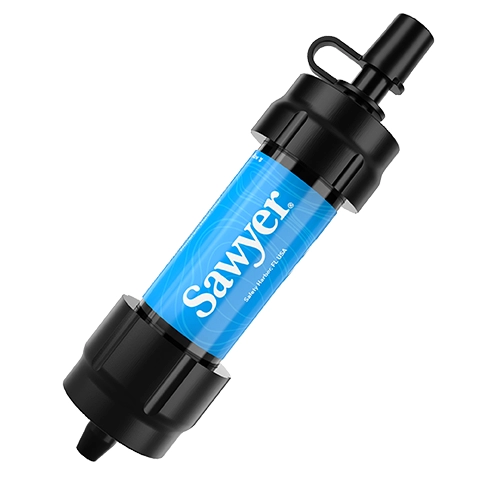
Key Specs
Weight: 1.51 ounces (43 grams)
Longevity: 100 000 gallons (378 541 liters)
Price: $$
PROS
✅ Ultralight
✅ High quality
CONS
❌ Slow for large quantities of water
The Sawyer MINI is a popular ultralight water filter for backpackers. At only 2 ounces, it packs easily without weighing down your bag. Setup is simple – just attach it to the included squeeze bag or standard water bottles.
Where it excels is versatility. You can easily filter untreated water directly into your drinking vessel from a stream. It removes bacteria and protozoa down to 0.1 microns.
The hollow fiber membrane is susceptible to clogging if not cleaned after use. Flow rate may be slower for large volumes. Most importantly, the activated filter does not survive long-term dry storage and can fully clog.
Provided it’s properly maintained between trips by thorough cleaning and air drying, the versatile Sawyer MINI conveniently filters clean water for lightweight backpacking. Just be diligent in care to maximize its lifespan. When treated well, it’s a reliable way to purify water on the trail.
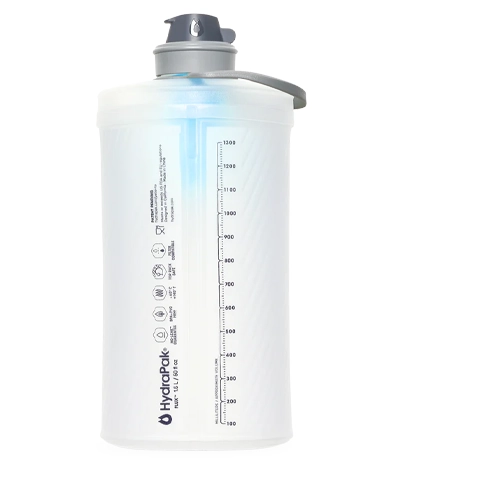
Key Specs
Weight: 5 ounces (143 grams)
Volume: 1.5L
Longevity: 396 gallons (1500 liters)
Price: $$$
PROS
✅ Collapsible design
✅ High quality
CONS
❌ Relatively expensive
The HydraPak Flux+ 1.5L bottle offers ultra-light reusable hydration with built-in filtration. Its integrated <0.2 micron hollow fiber filter removes bacteria and protozoa from approximately 1,500 liters of water at an impressive rate of over 1L per minute.
Designed to fit easily into pack pockets when full and roll up neatly when empty, the Flux prioritizes space-saving storage. However, one downside is the lid – once filled, it can be difficult to open for a drink due to the lid’s flexibility combintion with full bottle weight.
That said, the Flux material and construction provides superb durability fit for long-term use. While a touch on the heavier side, its sturdiness makes it a worthwhile investment for those seeking reusable hydration without compromise to filtation quality or lifespan.
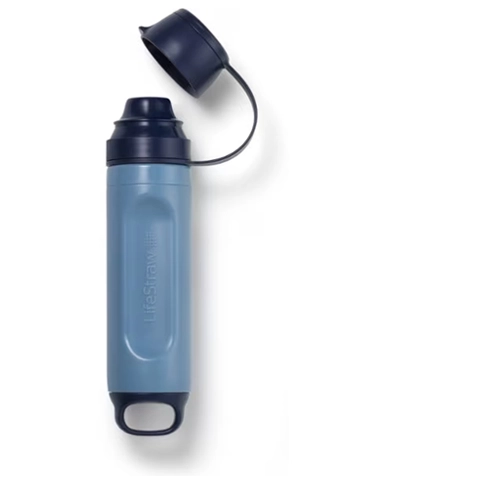
Key Specs
Weight: 1.7 ounces (48 grams)
Longevity: 528 gallons (2000 liters)
Price: $$
PROS
✅ Ultralight
✅ High quality
CONS
❌ Might not work with all European bottles
We tested the LifeStraw Solo on a couple backpacking trips and found it to be a great compact and portable water filtration option. At just 1.7 ounces, it easily fits in any backpack.
The 28mm threading allows it to screw onto most water bottles for fast and simple one-handed filtering – we were able to fill a liter bottle in 20 seconds.
We used it to effectively filter out bacteria and parasites from untreated water sources, as expected. With a capacity of 528 gallons (2000 liters), this filter will last us for years of continued use in the outdoors.
Just like when you travel across oceans, there is one thing you should know. The LifeStraw Solo may not fit onto all water bottles used in Europe. Sometimes the threading is different.
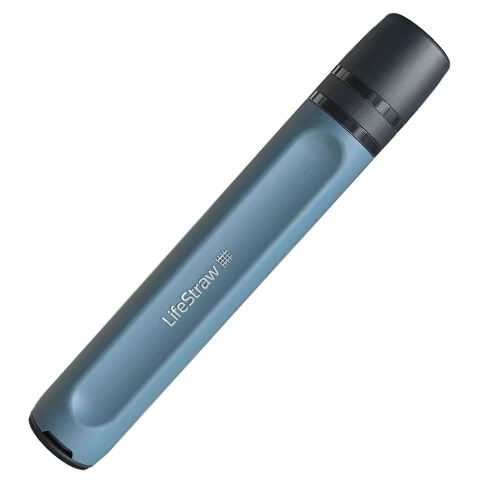
Key Specs
Weight: 2.39 ounces (68 grams)
Type: Filter
Longevity: 1000 gallons (4000 liters)
Price: $$
PROS
✅ High quality
✅ Sleek design
CONS
❌ Slow for large quantities of water
The LifeStraw is a highly portable water filtration option that packs essential peace of mind. Weighing just 2 ounces, it takes up minimal space yet offers critical functionality when water sources are uncertain.
Rather than filtering into a separate container, the LifeStraw allows for direct drinking from the source. This on-the-go usability is useful for refilling water bottles or in emergency situations.
LifeStraws have proven to be exceptionally durable – one straw can filter over 1,000 gallons (4000 liters) effectively. However, one downside is that you need to apply significant suction to draw water through at a reasonable rate.
For travelers prioritizing compactness without compromising basic treatment, the versatile LifeStraw delivers essential hydration security.
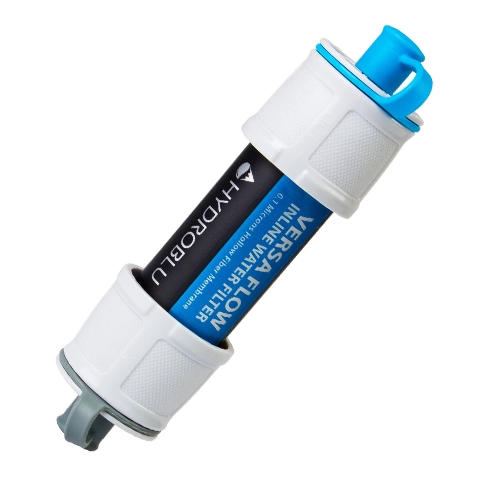
Key Specs
Weight: 1.90 ounces (54 grams)
Longevity: 100 000 gallons (378 541 liters)
Price: $
PROS
✅ Ultralight
✅ Great warranty
CONS
❌ Not the best seal with some water bags
The HydroBlu Versa Flow Water Filter is a versatile filter for outdoor adventures. Weighing only 1.9 ounces, it adds minimal bulk while offering multiple uses.
Use it directly on a water bottle, as a gravity filter attached to a bag, or even as a straw. This adaptation allows it to suit different situations on the trail.
It filters down to 0.1 microns, removing bacteria, parasites and microplastics. You can trust the water will be clean no matter how you filter.
The only minor issue is it may not seal tightly with some hydration bags, requiring an extra twist. But otherwise it functions reliably.
For the affordable price and various use options, the HydroBlu Versa Flow provides great value to ultralight backpackers looking for a flexible water treatment solution.
When backpacking, access to clean drinking water is essential. Backcountry water sources may contain harmful bacteria, viruses, and protozoa that can cause serious illnesses like giardia, cryptosporidiosis, and norovirus.
To protect yourself, you need an effective water treatment system. Here are some key factors to consider when selecting a backpacking water filter or purifier:
With criteria prioritized for your needs, you can zero in on the ideal backpacking water treatment system. Stay hydrated and healthy on your adventures!
When selecting a backpacking water filter, it’s important to consider factors like the type of contaminants present, micron size needed to remove bacteria and protozoa, weight for ultralight trips, desired flow rate if hiking in a group, maintenance needs, and filter material reliability. Lightweight options include gravity filters, squeeze filters and chemical treatments, but choose one that safely treats water sources containing viruses if a concern. Assess your filtering priorities like effective contaminant removal, acceptable ounces, and faster flow to stay hydrated for backcountry adventures at varying paces and group sizes.
The lifespan of a backpacking water filter can vary depending on the type and how often you use it. In general, most filters will treat around 100-200 gallons before needing to be replaced. Gravity filters tend to last the longest since they don’t have moving parts to wear down. Pump filters may only treat around 50 gallons before the pump wears out. Chemical treatments like chlorine tablets can treat over 1000 gallons. To get the most out of your filter, make sure to follow the manufacturer’s cleaning instructions. Taking good care of it can help your filter hit the average lifespan when treating water on multiple trips each year.
When camping and exploring the wilderness, it’s important to have safe drinking water. Backpacking water filters are an effective purification method to remove potential contaminants. Most filters can remove bacteria and protozoa like giardia and cryptosporidium, making water safer for consumption. Higher-end filters may also remove viruses, offering a greater level of protection. Certain filters even reduce chemicals like chlorine for better taste. Choosing the right filter allows for purification of water sources during adventures, giving peace of mind. Consider a filter’s rated contaminant removal before setting off to stay well-hydrated on trips in the wild.